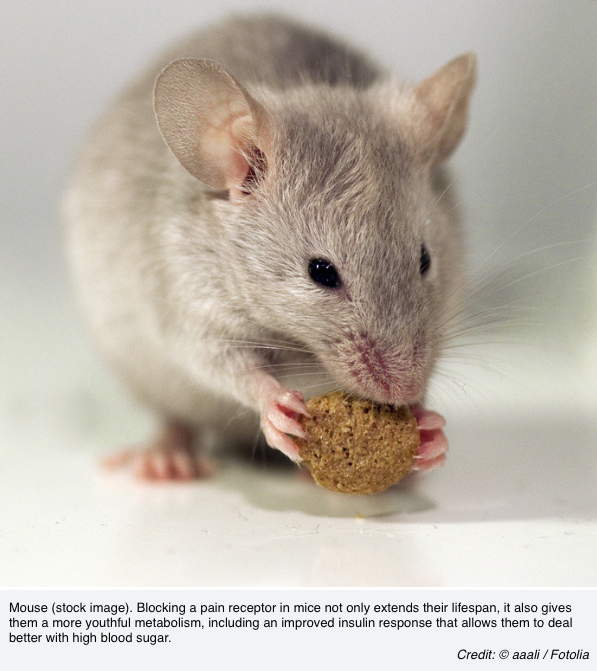Blocking a pain receptor in mice not only extends their lifespan, it also gives them a more youthful metabolism, including an improved insulin response that allows them to deal better with high blood sugar.
“We think that blocking this pain receptor and pathway could be very, very useful not only for relieving pain, but for improving lifespan and metabolic health, and in particular for treating diabetes and obesity in humans,” said Andrew Dillin, a professor of molecular and cell biology at the University of California, Berkeley, and senior author of a new paper describing these results. “As humans age they report a higher incidence of pain, suggesting that pain might drive the aging process.”
The “hot” compound in chili peppers – capsaicin – is already known to activate this pain receptor, called TRPV1, which is often called the capsaicin receptor. Constant activation of this receptor on a nerve cell results in the death of the neuron, mimicking the loss of the TRPV1 receptor, which could explain why diets rich in capsaicin have been linked to a lower incidence of diabetes and metabolic problems in humans.
More relevant, however, is an anti-migraine drug already on the market that inhibits a protein called CGRP that is triggered by TRPV1, producing an effect similar to that caused by blocking this receptor. Dillin showed that giving this drug to older mice restored their metabolic health to that of younger mice.
“Our findings suggest that pharmacological manipulation of TRPV1 and CGRP may improve metabolic health and longevity,” said Dillin, who is a Howard Hughes Medical Institute investigator and the Thomas and Stacey Siebel Distinguished Chair in Stem Cell Research. “Alternatively, chronic ingestion of compounds that affect TRPV1 might help prevent metabolic decline with age and lead to increased longevity in humans.”
Dillin and his colleagues at UC Berkeley and The Salk Institute for Biological Studies in La Jolla, Calif., will publish their results in the May 22 issue of the journal Cell.
Pain and obesity
TRPV1 is a receptor found in the skin, nerves and joints that reacts to extremely high temperatures and other painful stimuli. The receptor is also found in nerve fibers that contact the pancreas, where it stimulates the release of substances that cause inflammation or, like CGRP (calcitonin gene-related peptide), prevent insulin release. Insulin promotes the uptake of sugar from the blood and storage in the body’s tissue, including fat.
Past research has shown that mice lacking the TRPV1 receptor are protected against diet-induced obesity, suggesting that it plays a role in metabolism. Dillin and his team have now shown that mice lacking TRPV1 receptors lived, on average, nearly four months – or about 14 percent – longer than normal mice. The receptor-deficient mice also showed signs of a youthful metabolism late in life, due to low levels of CGRP (calcitonin gene-related peptide) – a molecule that blocks insulin release resulting in increased blood glucose levels and thus could contribute to the development of type 2 diabetes. Throughout aging, these mice showed improved ability to quickly clear sugar from the blood as well as signs that they could burn more calories without increasing exercise levels.
Moreover, old mice treated with the anti-migraine drug, which inhibits the activity of CGRP receptors, showed a more youthful metabolic profile than untreated old mice.
Source: Riera et al. TRPV1 Pain Receptors Regulate Longevity and Metabolism by Neuropeptide Signaling. Cell, May 2014












